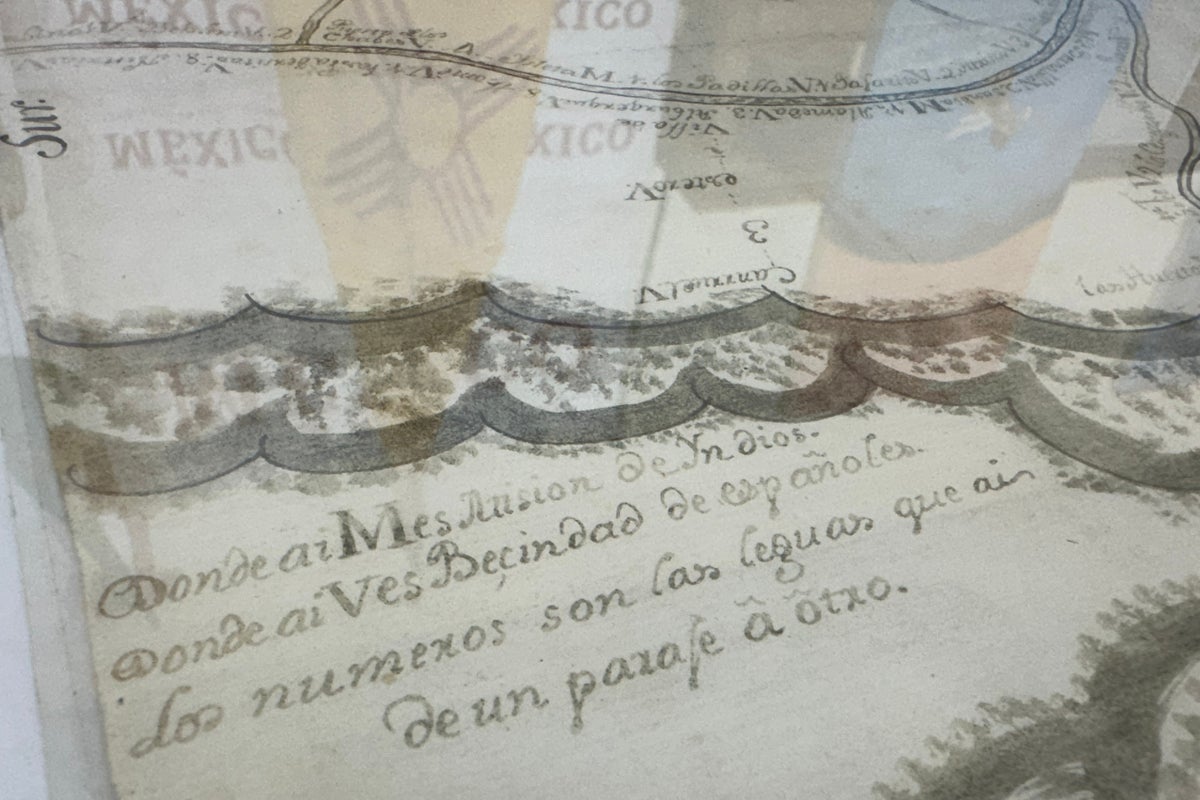Science
Centuries-Old Map Returned to Mexico After Discovery in Santa Fe

A historic map, crafted during the Spanish colonial era, has been returned to the Mexican government following a detailed investigation that spanned several years. This significant document, which reflects the early presence of Spanish settlers in what is now Mexico and the southwestern United States, was handed over during a ceremony at the Mexican consulate in Albuquerque.
FBI agents collaborated with Mexican officials, historians, and archivists for the official handover on March 5, 2024. Special Agent in Charge Justin Garris emphasized the importance of this map, noting it represents more than just ink on paper. Mexican Consul in Albuquerque, Patricia Pinzón, described the map as a crucial piece of her nation’s cultural heritage. “This document not only enriches our collective memory but also strengthens the ties that unite Mexico and New Mexico through a shared history,” she stated.
Historical Significance of the Map
The map prominently features the Camino Real de Tierra Adentro, a vital 1,600-mile (2,560-kilometer) route that historically connected Mexico City to Santa Fe. The document reveals the names of communities along this route, intricately illustrated alongside rivers and Native American settlements. Unlike modern maps, this one is oriented with north to the right and west at the top, showcasing a distinctive navigational style from its time.
Pinzón noted that this map is one of many archaeological and cultural items reclaimed by Mexico in recent years. Just last month, a 500-year-old manuscript page, signed by Spanish conquistador Hernán Cortés, was returned to Mexico, marking a renewed commitment to repatriating significant artifacts.
Discovery and Recovery Efforts
The journey of the map began in 2011, when archivists in Mexico City discovered it missing. It was among 75 items taken from the national archives, with evidence indicating pages had been removed from a volume. Following a five-year period with no leads, a breakthrough occurred when a librarian from the Fray Angélico Chávez History Library in Santa Fe conducted research on a map offered for sale. This librarian uncovered potential evidence of theft, prompting further investigation.
Billy Garrett, executive director of the museum, explained that Mexican archivists utilized negatives and microfilm to authenticate the map, confirming its origin. The FBI retained the map for approximately one year while final arrangements were made for its return. Garrett expressed satisfaction with the outcome: “We’re very glad that it’s gone back to its rightful owners, and we were glad we got to take care of it for a while.”
Federal investigators noted that Santa Fe, a hub for collectors and dealers of Spanish colonial art, was a fitting location for the map’s discovery. While they did not disclose specific details of the investigation, they confirmed that no charges will be filed related to the map’s theft.
Shared Cultural Heritage
During the handover ceremony, Manuel García y Griego, a history professor at the University of New Mexico, reflected on the importance of the map in understanding the region’s past. He recalled examining a computer image of the map a decade ago while researching at the Archivo General de la Nación in Mexico City. Similarly, Joseph Sánchez, founder of the Spanish Colonial Research Center at UNM, had previously photographed a copy for his own studies.
Sánchez highlighted the broader historical context, presenting additional maps that illustrated areas beyond current state borders. He remarked that the returned map is unique and sheds light on different settlement patterns.
Santa Fe Mayor Alan Webber expressed the community’s deep connection to history, stating, “We live history. It’s not something in the past. It’s part of our daily lives.” He suggested that the map represents a rich narrative shaped by generations of families in the area.
The return of this centuries-old map serves as a reminder of the lasting ties between Mexico and New Mexico, illustrating a shared legacy that continues to resonate today. The celebration of its return marks not only the recovery of a historic artifact but also the ongoing commitment to preserving cultural heritage.
-

 Health3 months ago
Health3 months agoNeurologist Warns Excessive Use of Supplements Can Harm Brain
-

 Health3 months ago
Health3 months agoFiona Phillips’ Husband Shares Heartfelt Update on Her Alzheimer’s Journey
-

 Science2 months ago
Science2 months agoBrian Cox Addresses Claims of Alien Probe in 3I/ATLAS Discovery
-

 Science2 months ago
Science2 months agoNASA Investigates Unusual Comet 3I/ATLAS; New Findings Emerge
-

 Science1 month ago
Science1 month agoScientists Examine 3I/ATLAS: Alien Artifact or Cosmic Oddity?
-

 Entertainment5 months ago
Entertainment5 months agoKerry Katona Discusses Future Baby Plans and Brian McFadden’s Wedding
-

 Science1 month ago
Science1 month agoNASA Investigates Speedy Object 3I/ATLAS, Sparking Speculation
-

 Entertainment4 months ago
Entertainment4 months agoEmmerdale Faces Tension as Dylan and April’s Lives Hang in the Balance
-

 World3 months ago
World3 months agoCole Palmer’s Cryptic Message to Kobbie Mainoo Following Loan Talks
-

 Science1 month ago
Science1 month agoNASA Scientists Explore Origins of 3I/ATLAS, a Fast-Moving Visitor
-

 Entertainment2 months ago
Entertainment2 months agoLewis Cope Addresses Accusations of Dance Training Advantage
-

 Entertainment3 months ago
Entertainment3 months agoMajor Cast Changes at Coronation Street: Exits and Returns in 2025









